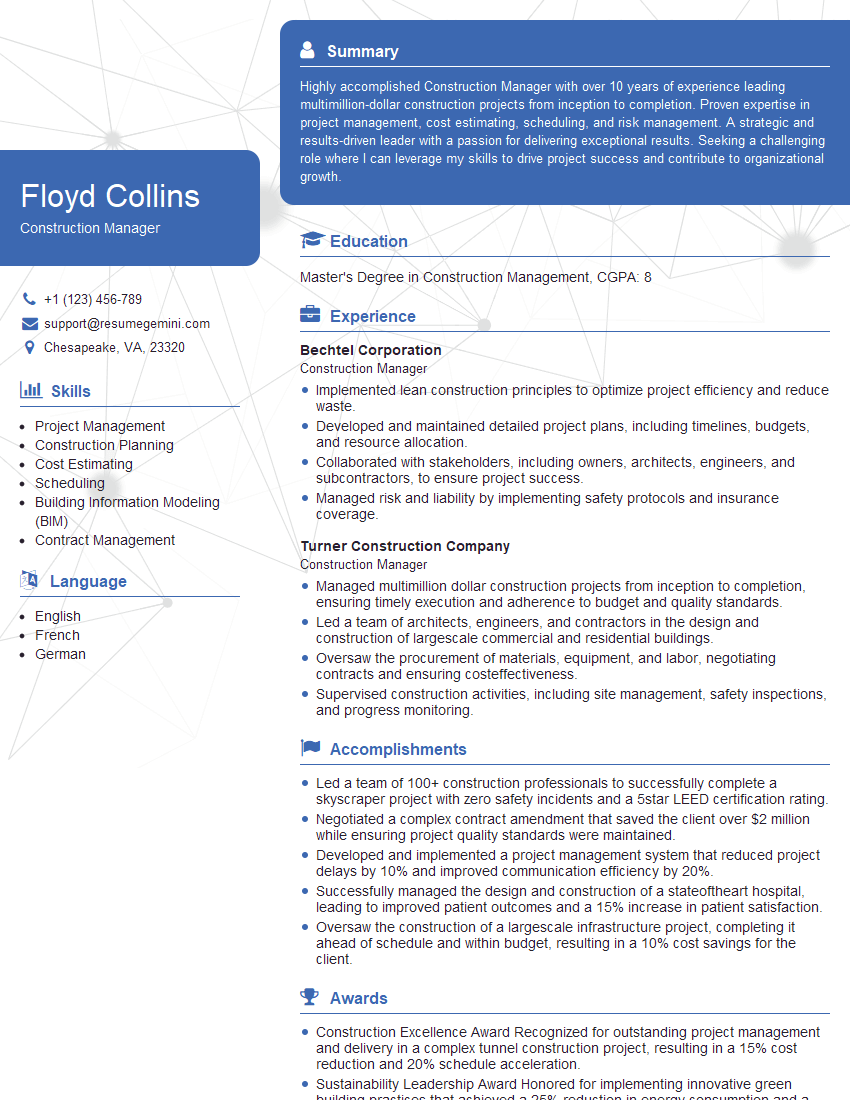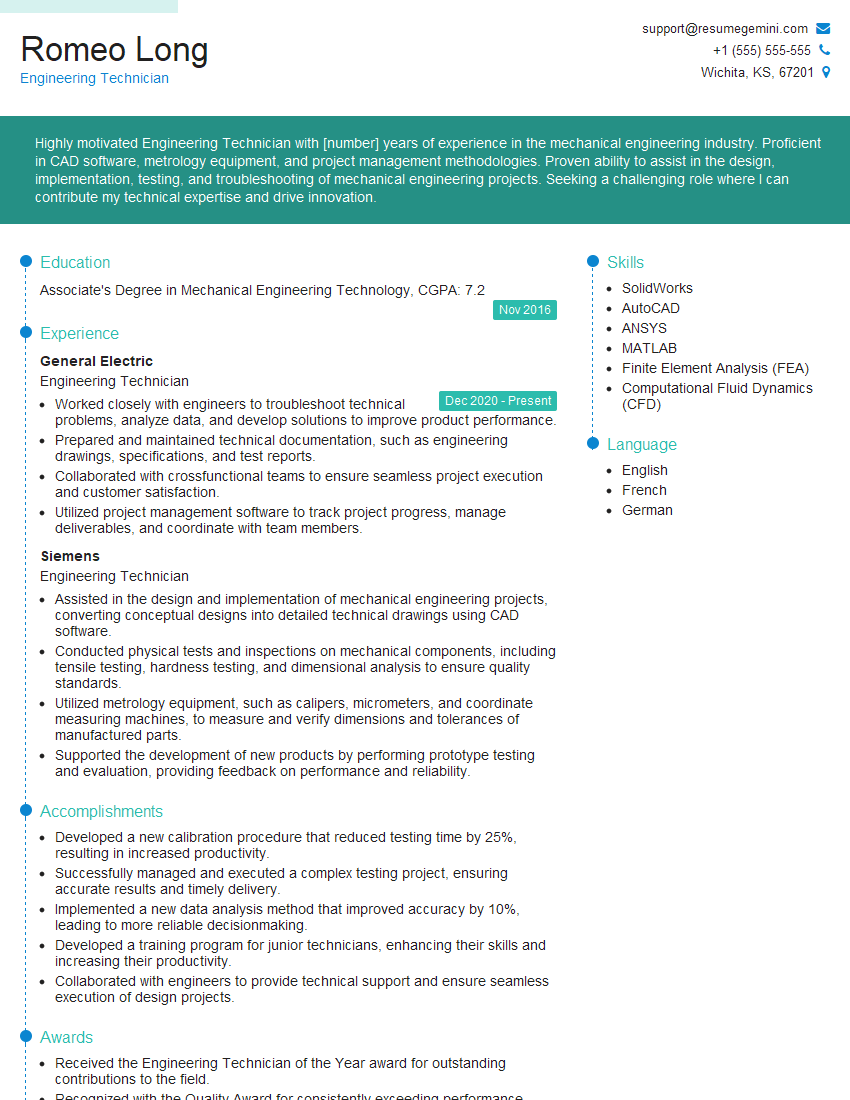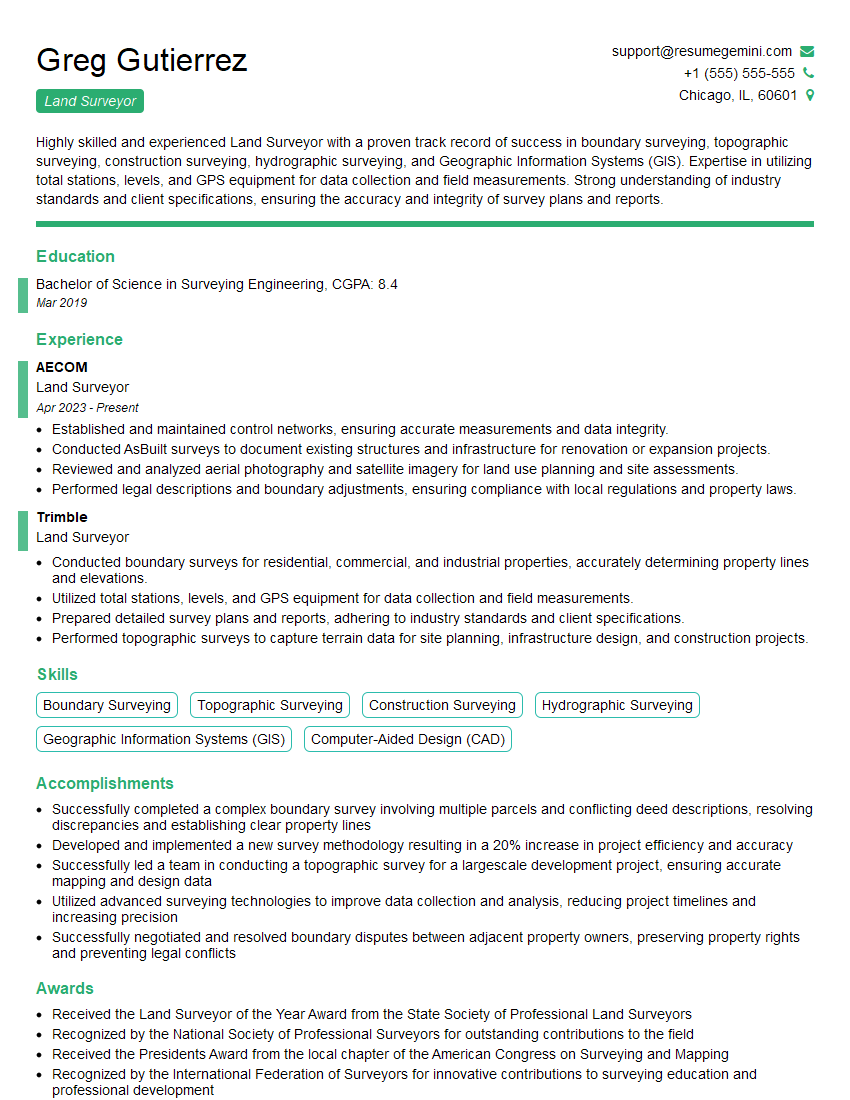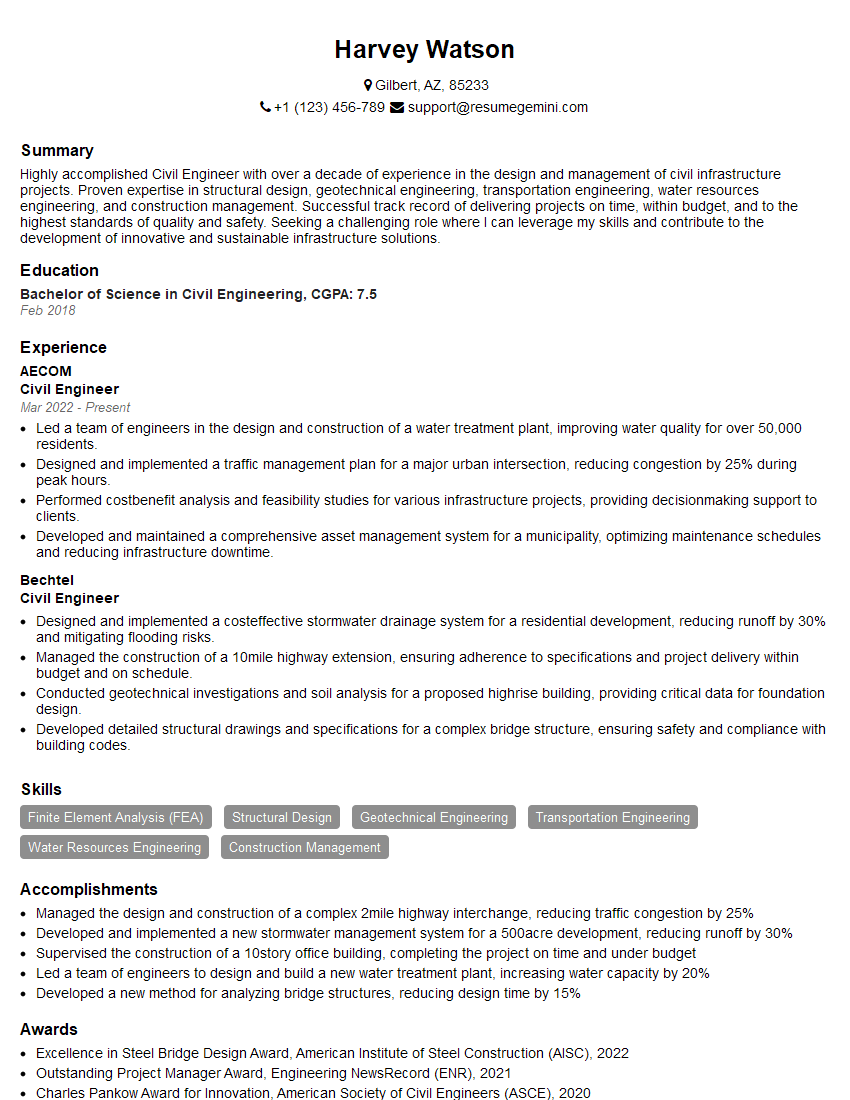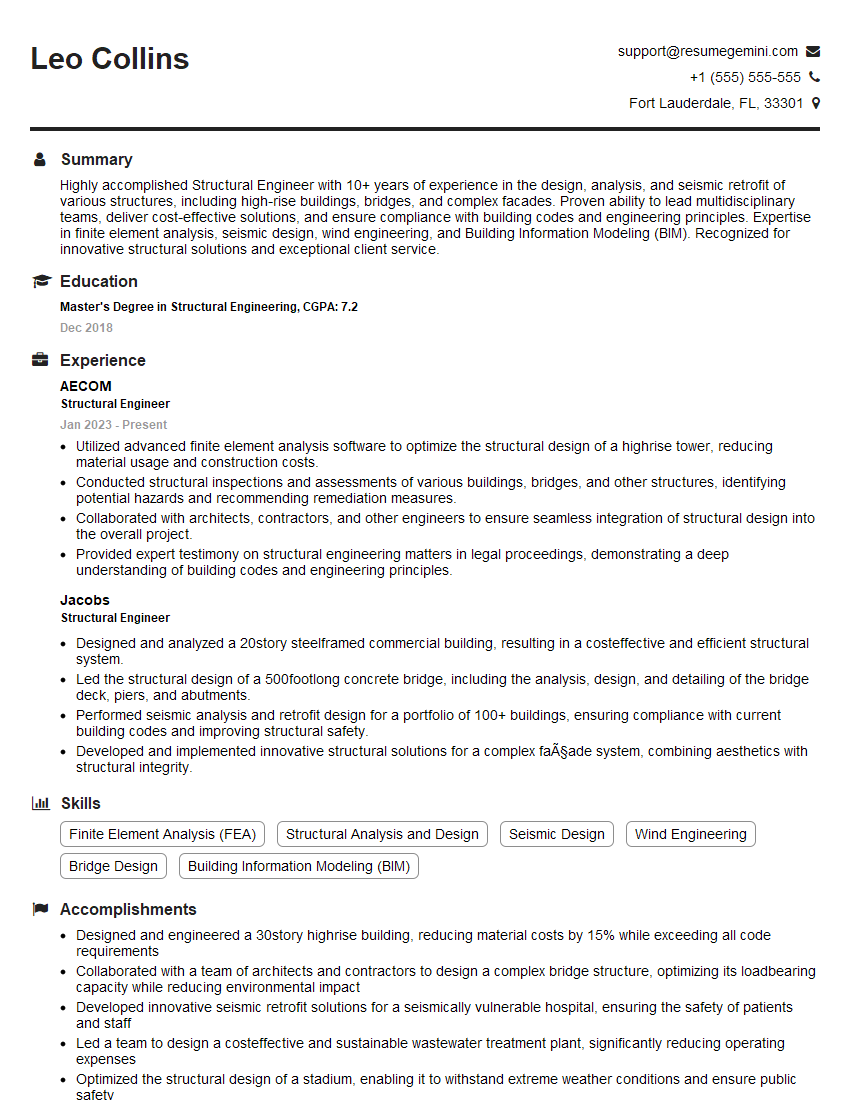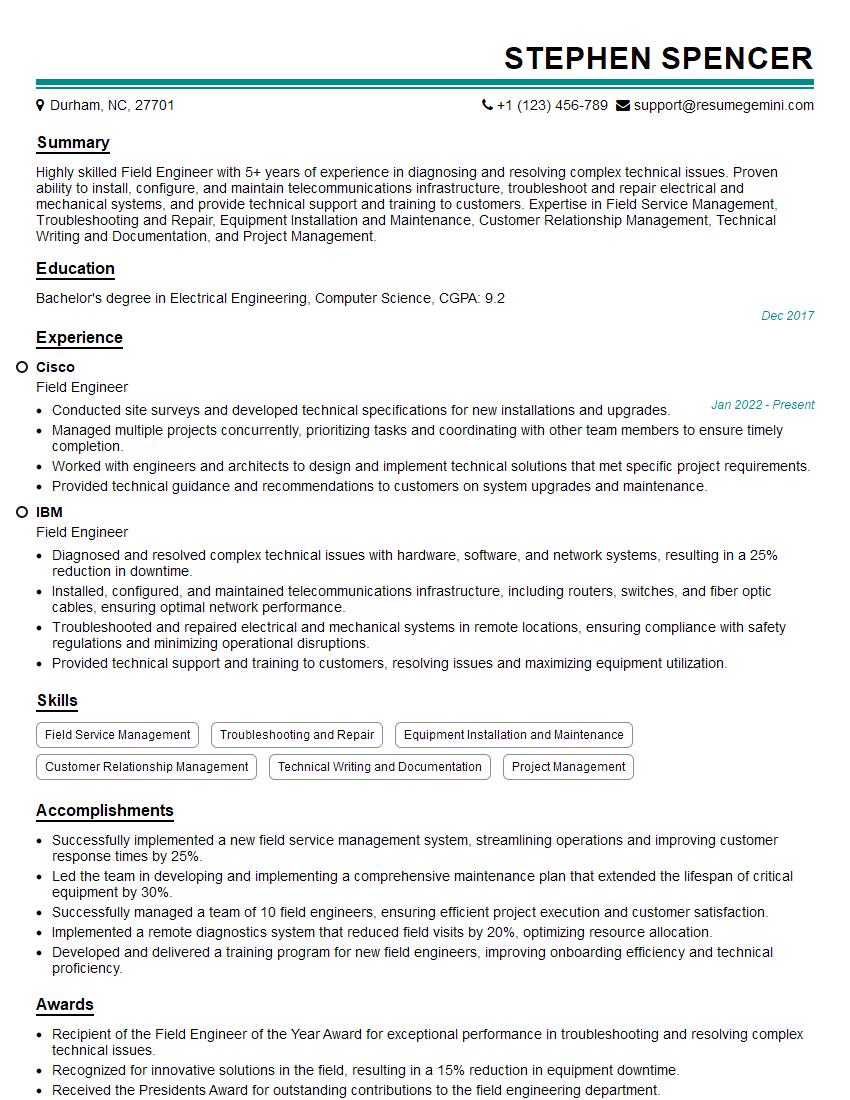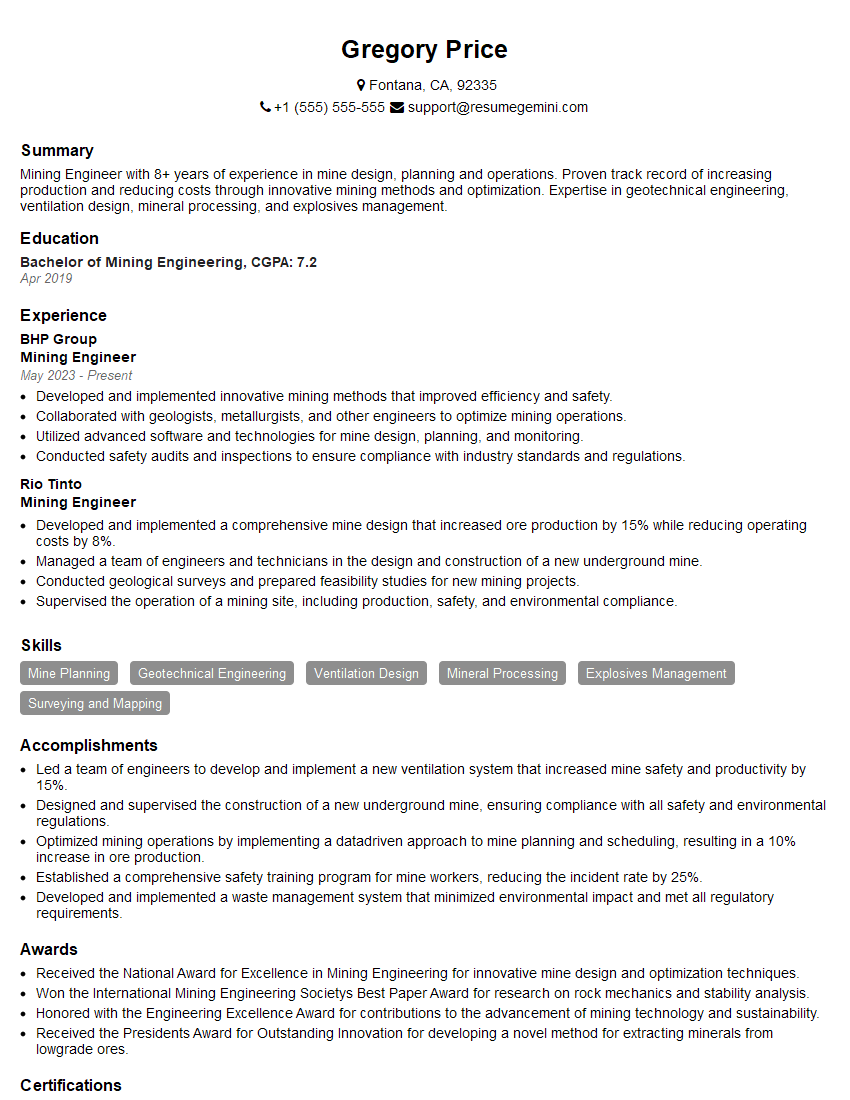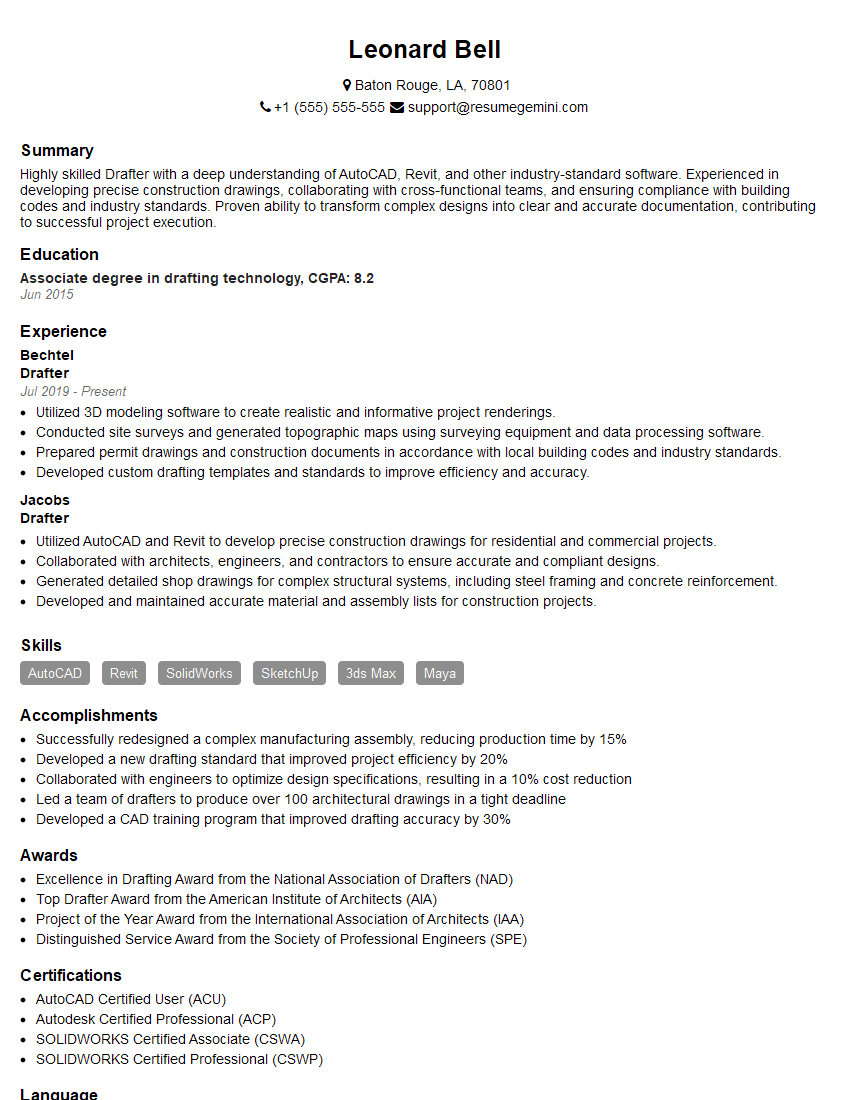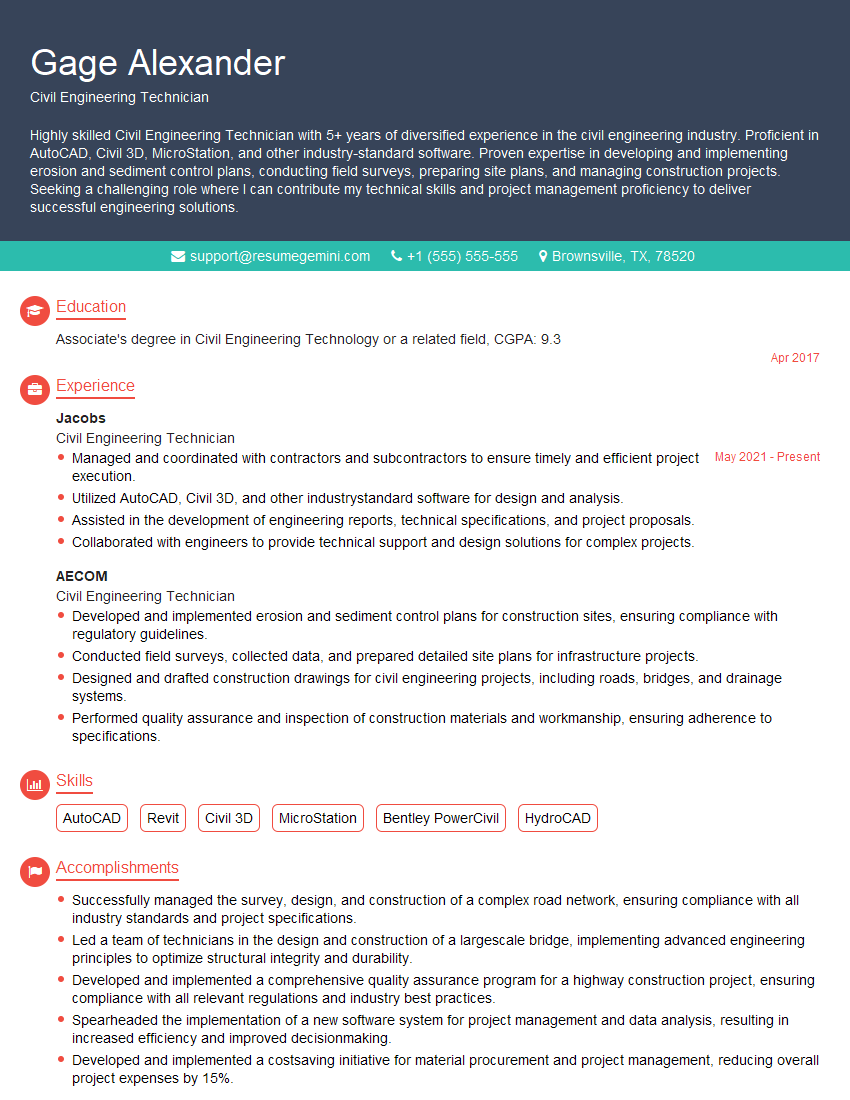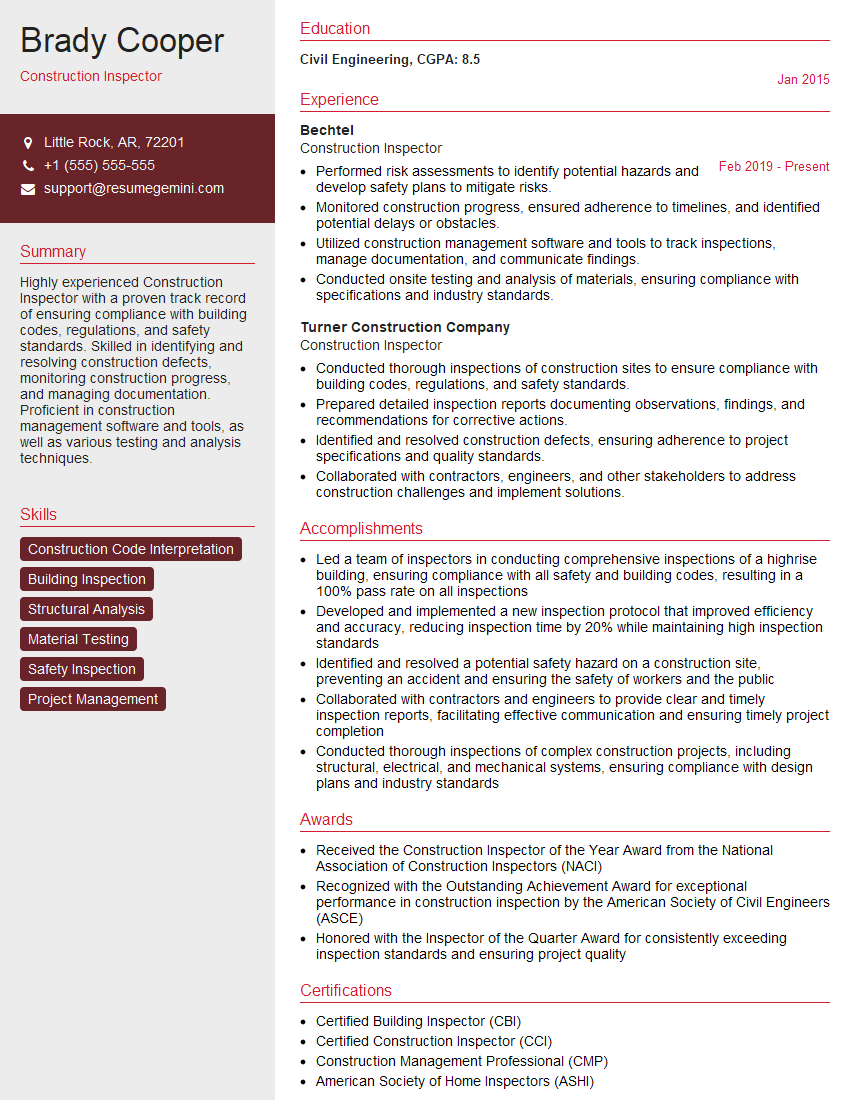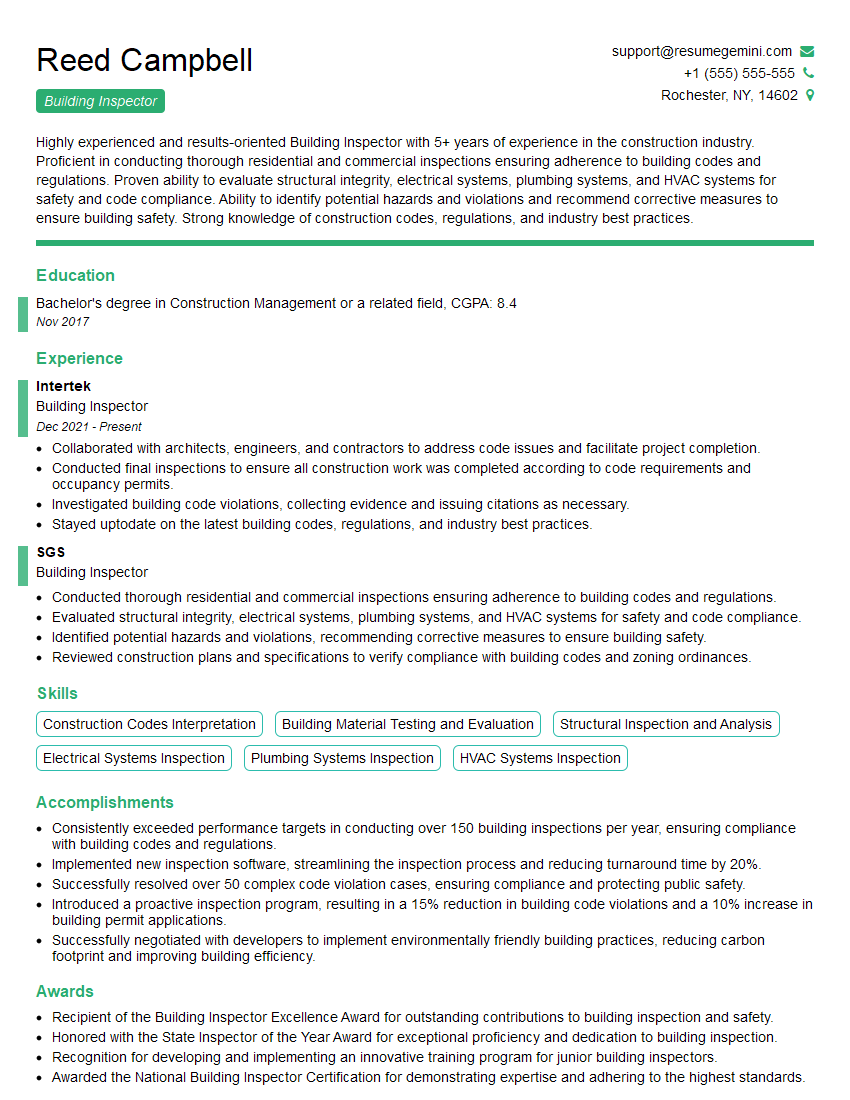Interviews are opportunities to demonstrate your expertise, and this guide is here to help you shine. Explore the essential Use of Measuring and Leveling Equipment interview questions that employers frequently ask, paired with strategies for crafting responses that set you apart from the competition.
Questions Asked in Use of Measuring and Leveling Equipment Interview
Q 1. Explain the principles of leveling.
Leveling, at its core, is the process of establishing a horizontal plane or determining the difference in elevation between two or more points. It relies on the principle of gravity; a level uses a precisely calibrated bubble vial to indicate when an instrument is perfectly horizontal. Imagine balancing a perfectly round ball on a perfectly flat surface – the ball will remain stationary. Similarly, the bubble in a level will sit exactly in the center when the instrument is level. Any deviation from center indicates an inclination. This principle is crucial in construction, surveying, and many other fields where accurate horizontal and vertical measurements are essential.
Q 2. Describe different types of levels and their applications.
Several types of levels cater to different needs and precision requirements:
- Spirit Levels (or Bubble Levels): These are simple, portable devices with a vial filled with liquid and a bubble. They are commonly used for basic leveling tasks in carpentry, plumbing, and DIY projects. Accuracy varies depending on the level’s quality; precision levels have finer graduations.
- Automatic Levels (Self-Leveling Levels): These levels use a compensator mechanism that automatically levels the line of sight, even if the instrument is slightly out of level. They’re faster and more efficient for surveying and larger-scale construction projects. They significantly reduce the need for precise initial setup.
- Digital Levels: These incorporate digital displays and sensors to measure and display the inclination directly in degrees or millimeters. They offer increased speed and accuracy, reducing human error during readings. They are widely used in advanced surveying, construction management, and machine alignment.
- Laser Levels: These project a laser beam to establish a horizontal or vertical plane over long distances. They’re particularly useful for larger construction projects, alignment tasks, and setting out building foundations. They often include rotary lasers that provide a 360-degree coverage.
The choice of level depends largely on the task’s complexity, required accuracy, and the scale of the project. A spirit level suffices for simple home improvements, while a digital or laser level might be necessary for precise engineering or construction tasks.
Q 3. How do you ensure accuracy when using a level?
Ensuring accuracy when using a level involves meticulous attention to detail in every step. First, select the right level for the job; a precision instrument is needed for high-accuracy applications. Second, always check the level’s calibration before use. Third, carefully position the level, ensuring it rests on a stable and level base; avoid shaky surfaces or uneven ground. Fourth, take multiple readings and average them to reduce the influence of minor errors. Fifth, use appropriate targets and accurately align the line of sight. Sixth, account for environmental factors like temperature that can impact readings. Finally, regularly maintain and calibrate your equipment to keep it in optimal condition. Imagine a carpenter building a perfectly level countertop; any inaccuracy in the leveling process will result in a poorly constructed, unusable countertop.
Q 4. What are the common sources of error in leveling?
Common sources of error in leveling include:
- Instrument Maladjustment: A misaligned bubble vial or malfunctioning compensator in an automatic level can significantly affect accuracy.
- Improper Setup: Setting the instrument on unstable ground or not properly leveling the tripod can introduce errors.
- Refraction: Light bends as it passes through different densities of air, particularly in hot or windy conditions. This affects the accuracy of long-distance leveling.
- Collimation Error: This refers to an error in the alignment of the telescope’s optical axis. It can introduce systematic errors, meaning the error consistently affects readings in the same direction.
- Target Misreading: Incorrectly reading the staff or target can result in significant errors, especially at longer distances.
- Settlement of Instrument or Staff: If the instrument or the leveling staff sinks into the ground during the measurements, it will lead to inconsistent results.
Understanding these potential errors is crucial for identifying and mitigating them during the leveling process. A poorly-levelled foundation, for instance, might lead to cracks in a building over time.
Q 5. How do you correct for errors in leveling?
Error correction in leveling often involves a combination of preventative measures and corrective calculations. Regular calibration and maintenance of equipment help prevent instrumental errors. Careful setup on stable ground and proper instrument handling minimize errors from improper setup. In case of significant errors, a double-run leveling method is often employed, where the readings are taken twice along the same route, but in opposite directions. This allows for the detection and elimination of systematic errors. Furthermore, advanced techniques like least squares adjustment are utilized in sophisticated surveying applications to mathematically correct for observed errors. The goal is to minimize the impact of unavoidable errors and provide the most accurate possible leveling results.
Q 6. Describe the process of setting up a level for a survey.
Setting up a level for a survey involves the following steps:
- Establish a Stable Base: Set up the tripod firmly on stable ground, ensuring it’s level as much as possible. Avoid soft ground or areas prone to settling.
- Level the Instrument: Use the leveling screws on the tripod head to center the bubble in the level’s vial. This ensures the instrument is horizontal.
- Sight the First Benchmark: Point the level at the first benchmark (a point of known elevation), which can be a previously established survey point or a temporary benchmark.
- Take Readings: Using a leveling staff, obtain accurate readings from the benchmark.
- Move to Next Station: Relocate the instrument to a new position to sight the next point, always ensuring that the instrument’s line of sight is clear and unobstructed.
- Repeat Readings: Continue the process, taking readings at each point along the survey route. Always check for accuracy with multiple readings.
- Record Data: Accurately record all readings, including the instrument’s height and the staff readings, using a properly formatted field book.
This process ensures that all elevations are relative to the initial benchmark and are accurately measured, forming the backbone of any surveying project. Think of it as building a stair-case, where each step’s height must be precisely measured and consistent to reach the desired level.
Q 7. Explain the difference between a level and a theodolite.
While both levels and theodolites are used in surveying, their primary functions differ significantly. A level is specifically designed for determining differences in elevation; it measures vertical angles with high accuracy to establish horizontal planes. Its line of sight is always kept horizontal. A theodolite, on the other hand, measures both horizontal and vertical angles with high precision. It’s used for a wider range of surveying tasks, including measuring distances, determining angles, and setting out curves. A theodolite can measure vertical angles, but its primary function isn’t levelling; rather, it’s for overall surveying and mapping needs. In short, a level is specialized for leveling, while a theodolite is a more general-purpose instrument with broader applications.
Q 8. What are the different types of measuring tapes and their uses?
Measuring tapes come in various types, each suited for different applications. The most common are:
- Steel tapes: These are highly accurate and durable, ideal for precise measurements in construction and surveying. They’re often longer than other types, sometimes reaching several hundred feet. Their rigidity makes them less prone to stretching than cloth tapes.
- Fiber glass tapes: Lighter and more flexible than steel tapes, these are less prone to breaking than steel but sacrifice some accuracy. They are commonly used in less demanding applications like home improvement projects.
- Cloth tapes: These are the most flexible and typically the least expensive. They’re convenient for quick measurements but prone to stretching over time, making them less accurate than steel or fiberglass. They’re mostly used for home projects or general measuring where precision isn’t critical.
- Electronic measuring tapes: These use sensors and internal processors to measure and display distances automatically. This removes the possibility of human error in reading, especially over longer distances. They’re generally used in professional settings that require speed and consistent precision.
The choice of tape depends heavily on the job’s requirements. For example, a surveyor building a high-rise would prioritize the accuracy of a steel tape, while a homeowner measuring for a shelf would find a cloth tape perfectly adequate.
Q 9. How do you measure distances accurately using a measuring tape?
Accurate distance measurement using a tape requires careful technique:
- Check the tape: Ensure the tape is undamaged and the zero mark is aligned correctly. Any kinks or damage could lead to inaccurate measurements.
- Establish a baseline: Clearly define the start and end points of your measurement.
- Keep the tape taut: A sagging tape will produce inaccurate results. Maintain consistent tension while measuring. Most tapes have a recommended tension stated in the manual, usually in pounds or newtons.
- Read the tape correctly: Align your eyesight perpendicular to the tape to avoid parallax error (apparent change in position when viewing something from a different angle). Record the measurement precisely to the nearest appropriate unit (e.g., millimeters, centimeters, inches).
- Measure in segments: For longer distances, break the measurement into shorter sections and add them together to minimize errors. Note down each segment carefully and perform the addition as a separate step to ensure accuracy. This reduces cumulative errors associated with longer stretches.
- Account for obstacles: If an obstacle blocks the line of sight, use appropriate techniques like offsetting to find the true distance.
Imagine you’re measuring the length of a room. Instead of stretching the tape across the entire room, you might measure in two sections, aligning the tape carefully between each section to prevent errors from the tape being unevenly taut or encountering obstacles.
Q 10. What are the precautions to take when using measuring tapes?
Safety and accuracy are paramount when using measuring tapes. Precautions include:
- Check for damage: Inspect the tape for any tears, kinks, or rust before use. A damaged tape can lead to significant measurement errors.
- Avoid sharp edges: Keep the tape away from sharp objects that could damage it.
- Proper handling: Don’t pull too hard on the tape; excessive force can damage or break it.
- Awareness of surroundings: Be aware of your surroundings and avoid tripping hazards while measuring.
- Correct storage: Store the tape properly – keep it clean, dry, and rolled up tightly when not in use. This prevents damage, rust, and ensures its longevity.
- Work with a partner: For measurements over long distances or in difficult-to-reach places, having a partner to assist reduces both the chances of error and of injury.
For instance, if you’re measuring the dimensions of a construction site, be mindful of heavy machinery, debris, and other construction workers to avoid accidents.
Q 11. Explain the use of a total station.
A total station is an electronic/optical instrument used in surveying and construction. It combines the functions of a theodolite (measures angles), an electronic distance meter (EDM, measures distances), and a data recorder. Essentially, it’s a sophisticated, highly precise measuring device. It uses lasers and electronic sensors to measure distances, angles (horizontal and vertical), and calculates coordinates of points in a 3D space. The collected data is then used to create accurate maps, plans, and models.
Think of it as a highly advanced, automated level and tape measure combined into one device, capable of measuring with extreme accuracy over longer distances and calculating spatial locations with ease.
Q 12. Describe the process of using a total station for surveying.
Using a total station for surveying involves several steps:
- Set up the instrument: Establish a stable base for the total station, ensuring it’s level and properly oriented. This often involves using a tripod and a leveling instrument.
- Establish a known point: Begin by measuring a known point, usually a benchmark with established coordinates. This acts as a reference point for all subsequent measurements.
- Measure points: Point the total station at the points you need to survey and record the horizontal and vertical angles, as well as the distance to each point. The instrument automatically calculates the coordinates of each point.
- Data collection and processing: The total station stores the data internally, which can then be downloaded to a computer for further processing and analysis. Software is often used to create maps, 3D models, and other deliverables.
- Quality control: Conduct checks for errors. This could involve re-measuring key points or comparing measurements to existing data to verify accuracy.
For example, when surveying a land parcel, you’d start by setting up the total station at a known point and then systematically measure the corners and other key features of the parcel. The data is then used to generate a precise boundary plan.
Q 13. What are the advantages and disadvantages of using a total station?
Total stations offer numerous advantages:
- High accuracy: They provide highly accurate measurements of distances and angles.
- Efficiency: They significantly speed up the surveying process compared to traditional methods.
- Data recording and processing: They automatically record data, simplifying data management and analysis.
- Versatility: They can be used for a wide range of surveying applications.
However, there are some disadvantages:
- Cost: Total stations are expensive to purchase and maintain.
- Complexity: They require specialized training and expertise to operate correctly.
- Environmental limitations: Atmospheric conditions (e.g., fog, heavy rain) can affect the accuracy of distance measurements.
- Line of sight: Obstructions can limit the range of measurements.
The initial investment in a total station is high, but the long-term benefits of increased speed and accuracy often outweigh the cost in large-scale projects.
Q 14. How do you ensure the accuracy of measurements taken with a total station?
Ensuring accuracy with a total station involves several steps:
- Proper calibration: Regularly calibrate the instrument to maintain accuracy. This is usually done by a qualified technician.
- Correct setup: Ensure the instrument is properly leveled and oriented before taking measurements.
- Environmental considerations: Account for environmental factors like temperature, atmospheric pressure, and humidity, as these can influence the accuracy of EDM measurements. Modern total stations often have built-in sensors and software to compensate for these factors.
- Instrument checks: Perform regular checks on the instrument’s functionality, including the EDM and the theodolite.
- Redundant measurements: Take multiple measurements of the same point to check for consistency and identify potential errors.
- Data processing checks: Carefully review the processed data for any inconsistencies or anomalies.
Imagine you’re surveying a bridge. To ensure the accuracy of the dimensions, you’d conduct redundant measurements of critical points, ensuring each point is checked multiple times to verify consistency. This helps eliminate any small errors that might arise from factors such as instrument drift or temporary environmental issues.
Q 15. Explain the principles of triangulation.
Triangulation is a fundamental surveying technique used to determine the location of a point by measuring the angles to it from known points. Imagine you’re standing at point A and you want to find the location of a distant tree (point C). You can’t directly measure the distance to the tree, but you can measure the angles to it from two other known points (A and B). By measuring the angle at A to the tree, the angle at B to the tree, and the distance between A and B, you can use trigonometry to calculate the distance from A to C, and the distance from B to C. This then precisely locates point C.
This principle relies on the geometric properties of triangles. We use the known lengths and angles to solve for the unknown lengths and angles, effectively pinpointing the location of the target. In practice, this might involve using a theodolite to accurately measure the angles, and a measuring tape or EDM (Electronic Distance Measurement) instrument to measure the distance between the known points.
- Precise Measurement: Accurate angle measurements are crucial for triangulation’s success. Even small errors can significantly impact the final result.
- Baseline Measurement: Establishing a reliable baseline (distance between known points) is critical.
- Multiple Triangulation: For increased accuracy, multiple triangulations can be performed to check for consistency and to compensate for potential errors.
Career Expert Tips:
- Ace those interviews! Prepare effectively by reviewing the Top 50 Most Common Interview Questions on ResumeGemini.
- Navigate your job search with confidence! Explore a wide range of Career Tips on ResumeGemini. Learn about common challenges and recommendations to overcome them.
- Craft the perfect resume! Master the Art of Resume Writing with ResumeGemini’s guide. Showcase your unique qualifications and achievements effectively.
- Don’t miss out on holiday savings! Build your dream resume with ResumeGemini’s ATS optimized templates.
Q 16. Describe the use of GPS in surveying and construction.
GPS (Global Positioning System) has revolutionized surveying and construction. It allows for rapid and accurate determination of coordinates in three dimensions. In surveying, GPS is used for:
- Control Point Establishment: Creating a network of precisely located points for referencing other measurements.
- Topographical Surveys: Mapping the earth’s surface features by recording the coordinates of numerous points.
- Construction Layout: Accurately marking out building foundations, roads, and other structures based on design plans.
- Machine Guidance: Guiding heavy equipment like excavators and graders to precisely follow planned lines and grades.
GPS receivers use signals from multiple satellites to calculate their position. The more satellites visible, the higher the accuracy. In construction, Real-Time Kinematic (RTK) GPS provides centimeter-level accuracy, enabling precise positioning of equipment and construction elements. This significantly reduces surveying time and improves the overall quality of construction projects. For example, it allows for the accurate placement of utility lines, minimizing the risk of damage during the construction of roadways.
Q 17. What are the limitations of GPS in surveying?
Despite its advantages, GPS has limitations in surveying:
- Signal Obstructions: Buildings, trees, and other obstacles can block GPS signals, leading to inaccurate readings or complete signal loss. This is especially problematic in urban canyons or heavily forested areas.
- Atmospheric Effects: The ionosphere and troposphere can affect GPS signals, causing delays and errors in positioning.
- Multipath Errors: GPS signals can bounce off surfaces before reaching the receiver, creating multipath errors and distorting the calculated position. This can be particularly significant in areas with many reflective surfaces such as buildings or bodies of water.
- Receiver Limitations: The accuracy of a GPS receiver depends on its quality and capabilities. Inexpensive receivers may have lower accuracy than high-precision survey-grade receivers.
- Satellite Geometry (GDOP): The geometric arrangement of satellites relative to the receiver impacts accuracy. Poor geometry (high GDOP) can lead to larger errors.
These limitations highlight the need for understanding the limitations of GPS and employing appropriate mitigation strategies.
Q 18. How do you deal with GPS signal loss?
Dealing with GPS signal loss requires a multi-pronged approach:
- Multiple Receivers: Using multiple GPS receivers can help mitigate signal loss. If one receiver loses signal, others may still maintain contact with sufficient satellites.
- Base Station: Establishing a nearby base station with a known precise location and using RTK (Real-Time Kinematic) GPS can help maintain accurate positioning even with temporary signal loss. The base station acts as a reference point, allowing correction of errors.
- Alternative Methods: When GPS signal loss is persistent, revert to traditional surveying methods such as total station measurements or triangulation.
- Strategic Positioning: Carefully selecting locations for measurements to minimize the chances of obstruction. Open skies are always preferable.
- Signal Enhancement: Using GPS antennas with signal amplifiers or employing techniques like choke rings to reduce multipath effects.
A common strategy is to have a planned backup method. Knowing when and how to transition between GPS and more traditional methods is crucial for efficient surveying operations.
Q 19. Explain the importance of calibration in measuring equipment.
Calibration is the process of comparing a measuring instrument’s readings to a known standard to verify its accuracy. It’s essential for ensuring reliable and consistent measurements. Without regular calibration, instruments can drift from their true values, leading to errors in measurements which can have serious consequences depending on the application. Imagine building a bridge where the structural components are slightly misaligned due to inaccurate measurements caused by uncalibrated equipment – the consequences could be catastrophic. Calibration ensures that measuring equipment conforms to predetermined standards and specifications, providing confidence in the data it generates.
Calibration involves comparing readings from the instrument to those from a traceable standard with known accuracy. The difference between the two readings is then used to adjust or correct the instrument.
Q 20. How often should measuring equipment be calibrated?
The frequency of calibration depends on several factors: the type of equipment, its use intensity, the precision required, and manufacturer’s recommendations. Some instruments may require calibration daily, while others might only need it annually. For example, a precision level used in high-stakes engineering projects might require monthly calibration, whereas a basic tape measure used for less demanding tasks might only need checking every few months.
The best practice is to refer to the manufacturer’s guidelines for specific calibration intervals. A good calibration log should be maintained, recording each calibration event and its results. This allows for tracking any changes in the instrument’s performance over time.
Q 21. Describe the process of calibrating a level.
Calibrating a level involves checking its accuracy using a calibrated leveling rod and a known distance. The process typically includes:
- Two-Peg Test: Set up two pegs a distance apart (at least 50 meters is ideal). Establish a level line between them. Measure the difference in readings.
- Correction Factor Calculation: Calculate the amount of error based on the reading difference. This is often half the error.
- Adjustment (If Necessary): Most levels have adjustable screws to correct errors identified from the two-peg test. If necessary, adjust these until the level reads correctly.
- Re-check: Perform the two-peg test again to verify the correction and ensure accuracy.
It’s crucial to use a calibrated leveling rod during calibration. The rod is a known standard, and any errors in the rod will affect the calibration of the level. Proper calibration procedures should be followed carefully, as any mistakes can lead to inaccuracies in the leveling instrument.
Q 22. What are the safety precautions to take when using measuring equipment?
Safety is paramount when using measuring equipment. It begins with a thorough understanding of the specific equipment you’re using – its limitations, potential hazards, and proper operating procedures. This includes reading the manufacturer’s instructions carefully.
- Personal Protective Equipment (PPE): Always wear appropriate PPE, such as safety glasses to protect against flying debris (especially with laser levels), hard hats in construction environments, and sturdy gloves to prevent cuts or slips.
- Environmental Awareness: Be mindful of your surroundings. Avoid working near energized lines or hazardous materials. Ensure the work area is clear of obstructions to prevent trips and falls.
- Proper Handling: Handle equipment carefully, avoiding dropping or mishandling instruments which can lead to damage or inaccurate readings. For delicate instruments like theodolites, use the provided carrying case and transport them carefully.
- Calibration and Maintenance: Regularly check and calibrate your equipment according to manufacturer guidelines to ensure accuracy and reliability. Damaged or improperly maintained equipment can lead to inaccurate measurements and potential safety hazards.
- Working at Heights: When using measuring equipment at heights, adhere strictly to fall protection protocols, using harnesses, lifelines and appropriate safety equipment.
For instance, I once noticed a colleague wasn’t wearing safety glasses while using a laser level. I immediately corrected them, emphasizing the risk of eye damage from accidental exposure to the laser beam.
Q 23. How do you handle discrepancies in measurements?
Discrepancies in measurements are inevitable, but understanding their source is crucial. I follow a systematic approach:
- Re-measurement: First, I repeat the measurement several times using the same equipment. This helps identify if the initial discrepancy was due to a simple human error.
- Equipment Check: I carefully inspect the equipment for any signs of damage or malfunction. Is the instrument properly calibrated? Are the batteries low? This step might involve comparing readings against a known standard.
- Environmental Factors: I consider external factors that might influence the measurement – temperature fluctuations, wind, or ground movement, for example. These can subtly affect the accuracy of some instruments.
- Data Analysis: If discrepancies persist, I analyze the entire dataset to identify any patterns or systematic errors. Statistical methods can help pinpoint outliers or trends.
- Different Equipment: In cases where significant and unexplained discrepancies remain, I employ a different type of measuring equipment as a verification method.
For example, while surveying a large plot of land, I encountered a significant difference between my initial measurements and those of my partner. By re-checking our equipment (a total station and a tape measure), we discovered a slight misalignment in the total station which we adjusted accordingly.
Q 24. Describe your experience with different types of measuring equipment.
My experience encompasses a wide range of measuring equipment, both traditional and electronic. This includes:
- Traditional Tools: Measuring tapes (steel and fiberglass), levels (builders’ levels, line levels), plumb bobs, and theodolites (optical and digital). I am proficient in using these for basic leveling and distance measurements and familiar with their limitations, such as susceptibility to errors from temperature changes or human inaccuracy with tape measures.
- Electronic Tools: Total stations, laser levels, laser distance meters (LDMs), and GPS receivers. I’m adept at operating these advanced instruments, understanding their functionalities, data acquisition methods, and the importance of proper data processing. Total stations, for instance, require expertise in setting up and correctly orienting the instrument to obtain precise measurements.
- Other Equipment: I have experience using other types of measuring equipment such as inclinometers, depth sounders and even specialized surveying drones for creating topographic maps. Each device has its strengths and weaknesses, and selecting the correct tool for the job is a crucial part of successful measurement.
One project involved using a combination of a total station and GPS receivers to create a highly accurate topographic map of a challenging terrain. The total station provided precise detail, whereas the GPS offered a broader perspective.
Q 25. How do you interpret survey data?
Interpreting survey data involves more than just reading numbers. It’s about understanding the context and extracting meaningful information. My process includes:
- Data Cleaning: The first step is checking for any errors or outliers in the data, which is often the result of issues in data recording, or environmental issues mentioned earlier.
- Data Organization: I organize the data into a structured format for easy analysis. This could involve creating spreadsheets or using dedicated surveying software.
- Data Analysis: This step might involve various techniques – calculating areas, volumes, distances, and elevations, identifying patterns, and comparing data with existing maps or plans.
- Visualization: Creating maps, diagrams, and cross-sections to visually represent the data aids in effective communication and identification of spatial relationships.
- Report Writing: Finally, I compile a detailed report summarizing the findings, which is often accompanied by diagrams, plans, and explanations of the conclusions derived from the measured data.
For instance, I once analyzed survey data to determine the volume of earthworks needed for a construction project. This involved using survey data to generate a 3D model of the site, calculating cut and fill volumes to optimize material movement and project costs.
Q 26. How do you use measuring equipment to solve real-world problems?
Measuring equipment plays a crucial role in solving numerous real-world problems. Here are some examples:
- Construction: Accurate measurements are essential for ensuring buildings are structurally sound and meet specifications. This involves everything from setting out foundations to verifying the accuracy of wall construction and overall dimensions.
- Land Surveying: Defining property boundaries, creating topographic maps, and conducting land-use planning all rely on precise measurements.
- Engineering: In civil engineering, measuring equipment is used to monitor infrastructure health, such as bridges and tunnels, to assess their stability and detect any potential structural issues.
- Accident Reconstruction: In forensic investigations, precise measurements are vital in reconstructing accident scenes, helping determine the cause and aiding in legal proceedings.
- Archaeology: Careful and meticulous measurement techniques are crucial for accurately recording the location and dimensions of artifacts and other historical features during archaeological excavations.
In one project, I used a total station to survey a site for a new highway, ensuring that the alignment was accurate and safe. Without accurate measurements, the highway could have posed safety issues, or deviated from the intended route.
Q 27. Explain your proficiency in using both electronic and traditional measuring tools.
I am proficient in using both electronic and traditional measuring tools, understanding their strengths and weaknesses. Traditional tools like measuring tapes and levels are useful for simple tasks and provide a good understanding of fundamental measurement principles. However, they are often less accurate and more time-consuming than electronic tools.
Electronic tools such as total stations and laser levels offer increased accuracy, efficiency, and data collection capabilities. They also provide digital records, simplifying data analysis and reducing the risk of human errors. For instance, a total station can measure distances and angles with incredible precision, significantly reducing the likelihood of errors associated with manual taping or optical leveling.
My skill lies not just in using these tools individually but also in selecting the appropriate equipment for the specific task at hand. I know when the simplicity and robustness of a traditional level is sufficient, and when the precision of a total station is required.
Q 28. Describe a time you had to troubleshoot a problem with measuring equipment.
During a large-scale land survey, the total station’s EDM (Electronic Distance Measurement) system started giving inconsistent readings. At first, I suspected a simple battery issue, but after replacing the batteries, the problem persisted.
I systematically investigated the problem:
- Visual Inspection: I carefully examined the instrument for any signs of physical damage or misalignment.
- Calibration Check: I performed a thorough calibration procedure, following the manufacturer’s guidelines.
- Environmental Factors: I checked for any atmospheric conditions (e.g., heavy fog) that might affect the EDM signals.
- Prism Check: I also verified the condition of the prisms, ensuring they were clean and properly positioned.
- Internal Diagnostics: The total station had internal diagnostic tools that helped pinpoint the malfunction – a faulty internal component in the EDM system.
Unfortunately, the problem couldn’t be fixed on-site, but because I had systematically identified the issue, I could accurately describe the problem, ensuring the instrument could be efficiently repaired and minimizing downtime for the project.
Key Topics to Learn for Use of Measuring and Leveling Equipment Interview
- Understanding Measurement Principles: Accuracy, precision, error analysis, and the impact of environmental factors on measurements.
- Types of Measuring Equipment: Familiarity with various tools like tapes, levels (dumpy, automatic, laser), theodolites, total stations, and their respective applications and limitations.
- Leveling Techniques: Mastering procedures for establishing benchmarks, running lines of levels, and calculating elevations. Understanding different leveling methods (e.g., direct, reciprocal).
- Practical Applications: Experience in site surveys, construction layout, grading, and alignment projects. Ability to explain how these tools are used in real-world scenarios.
- Data Recording and Analysis: Proper methods for recording measurements, calculating results, and presenting findings in a clear and organized manner. Proficiency in relevant software.
- Troubleshooting and Calibration: Identifying and resolving common equipment malfunctions and performing routine calibration procedures to ensure accuracy.
- Safety Procedures: Understanding and adhering to safety regulations when using measuring and leveling equipment, including proper handling and storage.
- Interpreting Drawings and Specifications: Ability to understand technical drawings and specifications to apply appropriate measuring and leveling techniques.
Next Steps
Mastering the use of measuring and leveling equipment is crucial for career advancement in many fields, opening doors to higher-paying roles and increased responsibility. A strong resume is your key to unlocking these opportunities. To significantly improve your job prospects, create an ATS-friendly resume that highlights your skills and experience effectively. ResumeGemini is a trusted resource that can help you build a professional and impactful resume. We provide examples of resumes tailored specifically to roles requiring expertise in the Use of Measuring and Leveling Equipment, helping you showcase your qualifications in the best possible light. Invest in your future – build a winning resume today!
Explore more articles
Users Rating of Our Blogs
Share Your Experience
We value your feedback! Please rate our content and share your thoughts (optional).
What Readers Say About Our Blog
good
